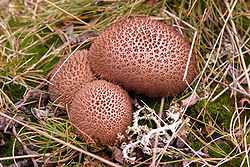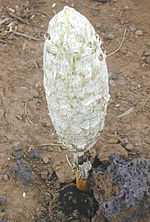Puffball
| Puffball | |
|---|---|
 | |
| Lycoperdon umbrinum, commonly known as the umber-brown puffball | |
| Scientific classification | |
| Kingdom: | Fungi |
| Division: | Basidiomycota |
A puffball is a member of any of several groups of fungi in the division Basidiomycota. The puffballs were previously treated as a taxonomic group called the Gasteromycetes or Gasteromycetidae, but they are now known to be a polyphyletic assemblage. The distinguishing feature of all puffballs is that they do not have an open cap with spore-bearing gills. Instead, spores are produced internally, in a spheroidal fruiting body called a gasterothecium (gasteroid ('stomach-like') basidiocarp). As the spores mature, they form a mass called a gleba in the centre of the fruiting body that is often of a distinctive color and texture. The basidiocarp remains closed until after the spores have been released from the basidia. Eventually, it develops an aperture, or dries, becomes brittle, and splits, and the spores escape. The spores of puffballs are statismospores rather than ballistospores, meaning they are not actively shot off the basidium. The fungi are called 'puffballs' because clouds of brown dust-like spores are emitted when the mature fruiting body bursts, or in response to impacts such as those of falling raindrops. Puffballs and similar forms are thought to have evolved repeatedly (that is, in numerous independent events) from hymenomycetes by gasteromycetation, through secotioid stages. Thus, 'Gasteromycetes' and 'Gasteromycetidae' are now considered to be descriptive, morphological terms (more properly gasteroid or gasteromycetes, to avoid taxonomic implications) but not valid cladistic terms.
Puffballs encompass the genera Calvatia, Calbovista and Lycoperdon.[1] The true puffballs, of the Lycoperdales, do not have a visible stalk (stem).
The stalked puffballs, of the lycoperdales, do have a stalk which supports the gleba. None of the stalked puffballs are edible as they are tough and woody mushrooms.[2] The Hymenogastrales are the false puffballs. A gleba which is powdery on maturity is a feature of true puffballs, stalked puffballs and earthstars. False puffballs are hard like rock or brittle. All false puffballs are inedible, as they are tough and bitter to taste. The genus Scleroderma, which has a young purple gleba, should also be avoided.[2]

Puffballs were traditionally used in Tibet for making ink by burning them, grinding the ash, then putting them in water and adding glue liquid and "a nye shing ma decoction", which, when pressed for a long time, made a very black dark substance which was used as ink.[3]
Edibility and identification

While most puffballs are not poisonous, some often look similar to young agarics, especially the deadly Amanitas, such as the death cap or destroying angel mushrooms. It is for this reason that all puffballs gathered in mushroom hunting should be cut in half lengthwise. Young puffballs in the edible stage, before maturation of the gleba, have undifferentiated white flesh within; whereas the gills of immature Amanita mushrooms can be seen if they are closely examined.

The giant puffball, Calvatia gigantea (earlier classified as Lycoperdon giganteum), reaches a foot (30 cm) or more in diameter, and is difficult to mistake for any other fungus. It has been estimated that a large specimen of this fungus when mature will produce around 7 × 10¹² spores. If collected before spores have formed, while the flesh is still white, it may be cooked as slices fried in butter, with a strong earthy, mushroom flavor. It can often be used in recipes that would ordinarily call for eggplant. It does not store well in a freezer - the entire freezer rapidly acquires a strong mushroom smell.
Not all true puffball mushrooms are without stalk. Some may also be stalked like the Podaxis pistillaris which is also called the False Shaggy Mane. On the other hand, there are a number of false puffballs that look similar to the true ones.[2]
- Stalked puffballs[2]
- Battarrea phalloides
- Calostoma cinnabarina (Stalked Puffball-in-Aspic)[4]
- Pisolithus tinctorius
- Tulostoma Simulans
- True puffballs[2]
- Bovista (various)
- Calvatia (various)
- Calvatia cyathiformis[2][4]
- Calvatia gigantea[2][4]
- Calvatia booniana
- Calvatia fumosa
- Calvatia lepidophora
- Calvatia pachyderma
- Calvatia sculpta
- Calvatia subcretacea
- Calbovista subsculpta
- Handkea utriformis
- Lycoperdon candidum
- Lycoperdon echinatum
- Lycoperdon fusillum
- Lycoperdon umbrinum
- Scleroderma auratium
- Scleroderma geaster
- False puffballs[2]
- Endoptychum agaricoides
- Nivatogastrium nubigenum
- Podaxis pistillaris
- Rhizopogon rubescens
- Truncocolumella citrina
Classification


Major orders:
- Lycoperdales, Tulostomatales, Nidulariales (related to Agaricales)
- Basidiomycetes : Agaricales : Lycoperdaceae : Calvatia
- Calvatia booniana -[2]
- Calvatia bovista (Handkea utriformis) -[5]
- Calvatia craniiformis -[4]
- Calvatia cyathiformis -[2][4]
- Calvatia fumosa (Handkea fumosa) -[2][5]
- Calvatia gigantea -[2][4]
- Calvatia lepidophora -[2]
- Calvatia rubroflava -[4]
- Calvatia sculpta -[2][5]
- Calvatia subcretacea (Handkea subcretacea) -[2][5]
- Basidiomycetes : Agaricales : Lycoperdaceae : Lycoperdon
- Lycoperdon foetidum (Lycoperdon nigrescens) [5]
- Lycoperdon perlatum -[4][5]
- Lycoperdon pulcherrimum -[4][5]
- Lycoperdon pusillum
- Lycoperdon pyriforme
- Basidiomycetes : Agaricales : Lycoperdaceae : Calvatia
- Geastrales and Phallales (related to Cantharellales),
- Basidiomycetes : Phallales : Geastraceae : Geastrum
- Sclerodermatales (related to Boletales)
- Basidiomycetes : Boletales : Sclerodermataceae : Scleroderma
- Scleroderma areolatum -[4]
- Scleroderma bovista -[4]
- Scleroderma cepa -[5]
- Scleroderma citrinum -[4]
- Scleroderma meridionale -[4]
- Scleroderma michiganense -[4]
- Scleroderma polyrhizum -[4]
- Scleroderma septentrionale -[4]
- Basidiomycetes : Boletales : Sclerodermataceae : Scleroderma
- and various false-truffles (hypogaeic gasteromycetes) related to different hymenomycete orders.
Similarly, the true truffles (Tuberales) are gasteroid Ascomycota. Their ascocarps are called tuberothecia.
Footnotes
- ↑ Freedman, Louise; Mycological Society of San Francisco (1987, 2000). "Wild About Mushrooms:Puffballs". Retrieved 2008-08-03
- ↑ 2.0 2.1 2.2 2.3 2.4 2.5 2.6 2.7 2.8 2.9 2.10 2.11 2.12 2.13 2.14 Miller, Orson K. (1977). Mushrooms of North America. New York, NY: E.P. Dutton Publisher. p. 298. ISBN 0-525-47482-X.
- ↑ Cuppers, Christoph (1989). "On the Manufacture of Ink." Ancient Nepal - Journal of the Department of Archaeology, Number 113, August–September 1989, p. 5.
- ↑ 4.0 4.1 4.2 4.3 4.4 4.5 4.6 4.7 4.8 4.9 4.10 4.11 4.12 4.13 4.14 4.15 4.16 4.17 Kuo, M. (2006, February). "Puffballs". MushroomExpert.Com. Retrieved 2008-08-03.
- ↑ 5.0 5.1 5.2 5.3 5.4 5.5 5.6 5.7 5.8 5.9 5.10 5.11 "The Fungi of California". Retrieved 2008-08-03.
References
- Homobasidiomycetes at the Tree of Life Web Project
External links
| Wikisource has the text of the 1911 Encyclopædia Britannica article Puff-ball. |
- Puffballs at AmericanMushrooms.com
- Puffballs on YouTube, 9-second video of a puffball releasing spores on YouTube.
- Puffballs or footballs